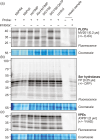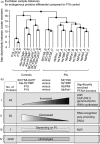Three unrelated protease inhibitors enhance accumulation of pharmaceutical recombinant proteins in Nicotiana benthamiana
- PMID: 29509983
- PMCID: PMC6131417
- DOI: 10.1111/pbi.12916
Three unrelated protease inhibitors enhance accumulation of pharmaceutical recombinant proteins in Nicotiana benthamiana
Abstract
Agroinfiltrated Nicotiana benthamiana is a flexible and scalable platform for recombinant protein (RP) production, but its great potential is hampered by plant proteases that degrade RPs. Here, we tested 29 candidate protease inhibitors (PIs) in agroinfiltrated N. benthamiana leaves for enhancing accumulation of three unrelated RPs: glycoenzyme α-Galactosidase; glycohormone erythropoietin (EPO); and IgG antibody VRC01. Of the previously described PIs enhancing RP accumulation, we found only cystatin SlCYS8 to be effective. We identified three additional new, unrelated PIs that enhance RP accumulation: N. benthamiana NbPR4, NbPot1 and human HsTIMP, which have been reported to inhibit cysteine, serine and metalloproteases, respectively. Remarkably, accumulation of all three RPs is enhanced by each PI similarly, suggesting that the mechanism of degradation of unrelated RPs follows a common pathway. Inhibitory functions HsTIMP and SlCYS8 are required to enhance RP accumulation, suggesting that their target proteases may degrade RPs. Different PIs additively enhance RP accumulation, but the effect of each PI is dose-dependent. Activity-based protein profiling (ABPP) revealed that the activities of papain-like Cys proteases (PLCPs), Ser hydrolases (SHs) or vacuolar processing enzymes (VPEs) in leaves are unaffected upon expression of the new PIs, whereas SlCYS8 expression specifically suppresses PLCP activity only. Quantitative proteomics indicates that the three new PIs affect agroinfiltrated tissues similarly and that they all increase immune responses. NbPR4, NbPot1 and HsTIMP can be used to study plant proteases and improve RP accumulation in molecular farming.
Keywords: Agrobacterium tumefaciens; Nicotiana benthamiana; activity-based protein profiling; agroinfiltration; protease inhibitor; transient expression.
© 2018 The Authors. Plant Biotechnology Journal published by Society for Experimental Biology and The Association of Applied Biologists and John Wiley & Sons Ltd.
Conflict of interest statement
The authors declare that they have no conflict of interests.
Figures







Similar articles
-
Activity-based proteomics reveals nine target proteases for the recombinant protein-stabilizing inhibitor SlCYS8 in Nicotiana benthamiana.Plant Biotechnol J. 2019 Aug;17(8):1670-1678. doi: 10.1111/pbi.13092. Epub 2019 Mar 14. Plant Biotechnol J. 2019. PMID: 30742730 Free PMC article.
-
The transcriptome, extracellular proteome and active secretome of agroinfiltrated Nicotiana benthamiana uncover a large, diverse protease repertoire.Plant Biotechnol J. 2018 May;16(5):1068-1084. doi: 10.1111/pbi.12852. Epub 2017 Dec 17. Plant Biotechnol J. 2018. PMID: 29055088 Free PMC article.
-
Co-expression With Replicating Vector Overcoming Competitive Effects Derived by a Companion Protease Inhibitor in Plants.Front Plant Sci. 2021 Jun 17;12:699442. doi: 10.3389/fpls.2021.699442. eCollection 2021. Front Plant Sci. 2021. PMID: 34220920 Free PMC article.
-
Improving transient protein expression in agroinfiltrated Nicotiana benthamiana.New Phytol. 2024 Aug;243(3):846-850. doi: 10.1111/nph.19894. Epub 2024 Jun 7. New Phytol. 2024. PMID: 38849321 Free PMC article. Review.
-
Molecular responses of agroinfiltrated Nicotiana benthamiana leaves expressing suppressor of silencing P19 and influenza virus-like particles.Plant Biotechnol J. 2024 May;22(5):1078-1100. doi: 10.1111/pbi.14247. Epub 2023 Dec 2. Plant Biotechnol J. 2024. PMID: 38041470 Free PMC article. Review.
Cited by
-
Development of Plant-Based Vaccines for Prevention of Avian Influenza and Newcastle Disease in Poultry.Vaccines (Basel). 2022 Mar 19;10(3):478. doi: 10.3390/vaccines10030478. Vaccines (Basel). 2022. PMID: 35335110 Free PMC article. Review.
-
Optimising expression and extraction of recombinant proteins in plants.Front Plant Sci. 2022 Dec 8;13:1074531. doi: 10.3389/fpls.2022.1074531. eCollection 2022. Front Plant Sci. 2022. PMID: 36570881 Free PMC article. Review.
-
Innovation in plant-based transient protein expression for infectious disease prevention and preparedness.Curr Opin Biotechnol. 2020 Feb;61:110-115. doi: 10.1016/j.copbio.2019.11.002. Epub 2019 Dec 6. Curr Opin Biotechnol. 2020. PMID: 31816585 Free PMC article. Review.
-
Production of Plant Proteins and Peptides with Pharmacological Potential.Adv Biochem Eng Biotechnol. 2024;188:51-81. doi: 10.1007/10_2023_246. Adv Biochem Eng Biotechnol. 2024. PMID: 38286902 Review.
-
Investigating Constraints Along the Plant Secretory Pathway to Improve Production of a SARS-CoV-2 Spike Vaccine Candidate.Front Plant Sci. 2022 Jan 4;12:798822. doi: 10.3389/fpls.2021.798822. eCollection 2021. Front Plant Sci. 2022. PMID: 35058959 Free PMC article.
References
-
- Altschul, S.F. , Gish, W. , Miller, W. , Myers, E.W. and Lipman, D.J. (1990) Basic local alignment search tool. J. Mol. Biol. 215, 403–410. - PubMed
-
- Bombarely, A. , Rosli, H.G. , Vrebalov, J. , Moffett, P. , Mueller, L.A. and Martin, G.B. (2012) A draft genome sequence of Nicotiana benthamiana to enhance molecular plant‐microbe biology research. Mol. Plant Microbe Interact. 25, 1523–1530. - PubMed
Publication types
MeSH terms
Substances
Associated data
- Actions
Grants and funding
LinkOut - more resources
Full Text Sources
Other Literature Sources
Molecular Biology Databases
Research Materials
Miscellaneous

